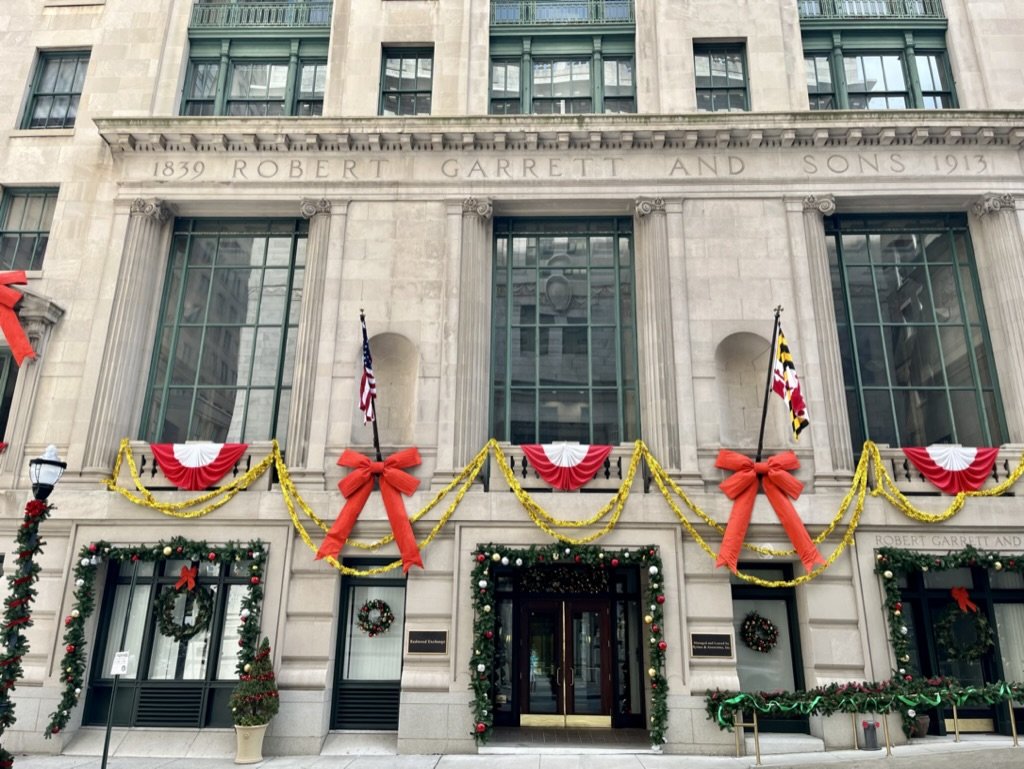About our History
Redwood Street History
The building was constructed by the family of John Work Garrett, a prominent entrepreneur and philanthropist in Baltimore who served as president of the Baltimore and Ohio Railroad for nearly 30 years. The Garrett Building is on the National Register of Historic Places. This 13- story building, completed in 1913, was designed by Baltimore architects J.B. Noel Wyatt and William G. Nolting. Reflecting a mixture of styles, this transitional building combines the Chicago windows, flat wall planes and flat sky-line characteristic of the Commercial style with Renaissance Revival details such as loggias, pedimented windows and rustication. From 1913 to 1974, the building housed Robert Garrett and Sons, one of the oldest and most influential banking houses in the country.
Robert Garrett (1783-1857), an Irish-born merchant-turned-financier, came to Baltimore as a young man in 1801 and clerked for several years in a produce and commission house. In 1819, he opened his own firm on Howard Street, dispatching such items as flint, chocolate and chalk to village stores out west, and receiving in return ginseng, snakeroot and whiskey. The business prospered and by mid-century, Robert Garrett and Sons were leaders in trade, shipping, railroads and finance. They and their descendants rose to extraordinary level of influence in the economic, social and civic affairs of the city, the state and the nation.
The adjacent Vickers Building also includes the venerable Werner’s Restaurant, a popular dining establishment that was opened by Werner Kloetzli in 1950 and chosen for the filming of numerous movies and television shows due to its distinctive chrome and maple Art Deco interior. The eatery had roles in The Wire, Liberty Heights, Ladder 49, Tin Men, Avalon and House of Cards.
In 2020, Kemp Byrnes, Brad Byrnes and Dave Gupta acquired 225 E. Redwood Street and 233 E. Redwood Street. The new owners executed a comprehensive $5 million redevelopment and rebranding strategy of the two properties.
225 E. Redwood Street, a four-story building formerly known as the Vickers Building was rebranded to Vickers Exchange. 233 E. Redwood Street, a 13-story building formerly known as the Garrett building was rebranded to the Redwood Exchange.
Why Redwood Street Represents Downtown History and Renewal
It’s worth asking, “Just what is downtown?” now that so much of Baltimore’s traditional business district has morphed into something else.
A sign wrapped around an aged office building proclaims it is being converted into new apartments.
The old Continental Trust, a landmark at Baltimore and Calvert streets, is the latest office to become bedrooms, kitchens and baths. This one comes with a nice history. It survived the Baltimore Fire of 1904 and was completely rebuilt after the flames ate through it.
The novelist Dashiell Hammett worked here for the Pinkerton detective agency in 1915 and clipped the name, “Continental Op” from his home office…
Five Minute Histories: Art & Architecture on Redwood Street
Watch this video, by Baltimore Heritage, to learn about art and architecture on Redwood Street
Mr. Vickers' Building and His Inventive Tenants
Much has been said about the Vickers Building (219-231 East Redwood Street, once German Street) mainly associated with 2001 preservationist efforts by the Historic American Buildings Survey (HABS) and the Maryland Historical Trust, in coordination with the City of Baltimore's Commission for Historical and Architectural Preservation (CHAP) and Preservation Maryland. Baltimore Heritage highlighted that the permit for this 'new' Vickers Building (to replace the old Vickers Building with ornate Second Empire style with Mansard roofs and complex architecture details) was issued on May 19, 1904, merely 3 months after the Great Baltimore Fire of 1904…
Back Story: Redwood St. Was Named For Hero of WWI
The drivers whizzing along Redwood Street through the heart of the city's old business district, which was once lined with brokerage houses, banks, the stock exchange and the old Merchants Club, probably have no idea for whom it is named.
Late last year, James Carl Nelson's book "Five Lieutenants," which told the story of five Harvard men who fought on the Western Front during World War I, was published. One of those men was George Buchanan Redwood, a newspaperman and editor who worked for the Baltimore News and was a member of the Harvard Class of 1910. When he was killed in action in 1918, Redwood became the first Baltimore officer to lose his life in the conflict…
Five Minute Histories: Gargoyles & Grotesques Part 2, South and Redwood
Watch this video, by Baltimore Heritage, to explore gargoyles and grotesques on South and Redwood Streets.






